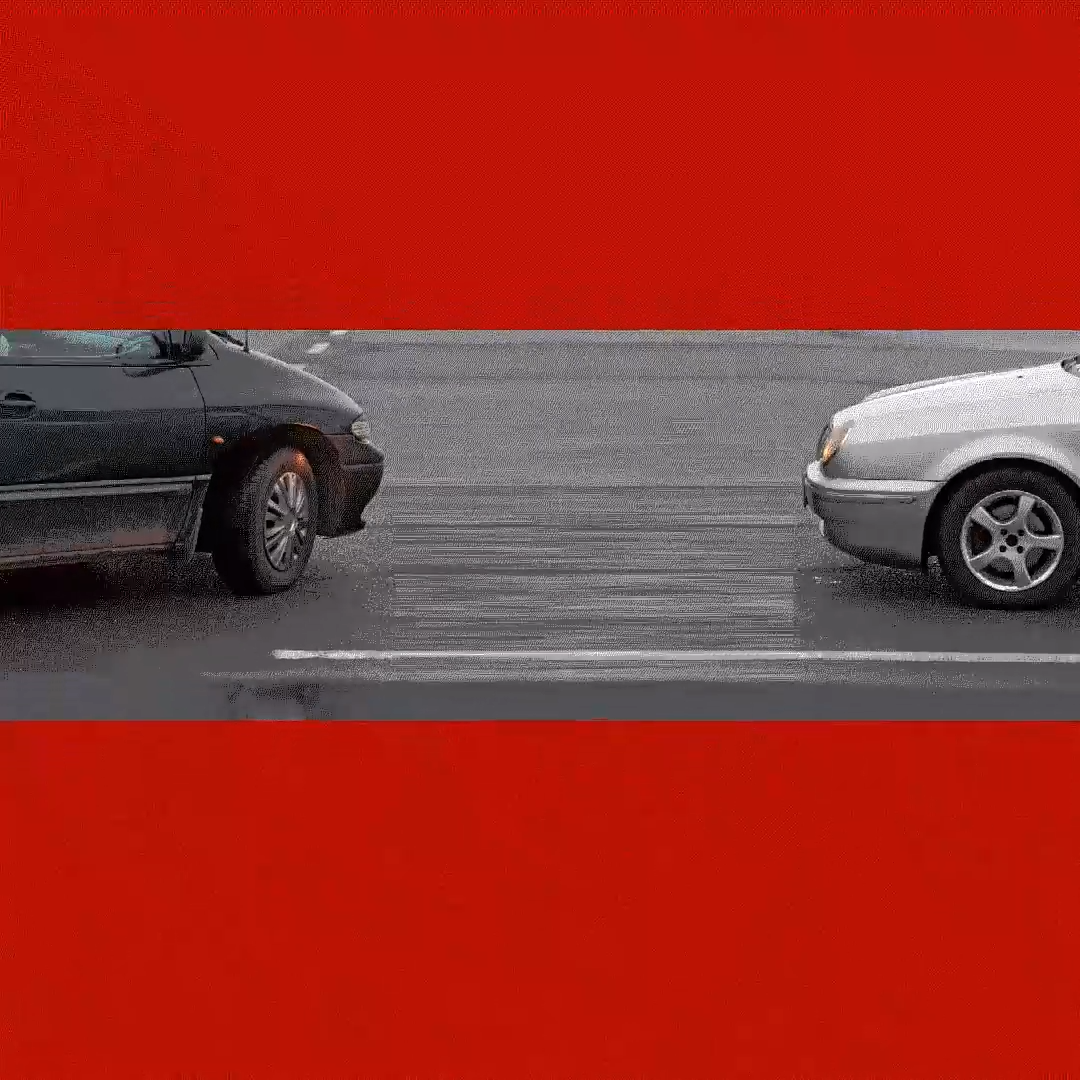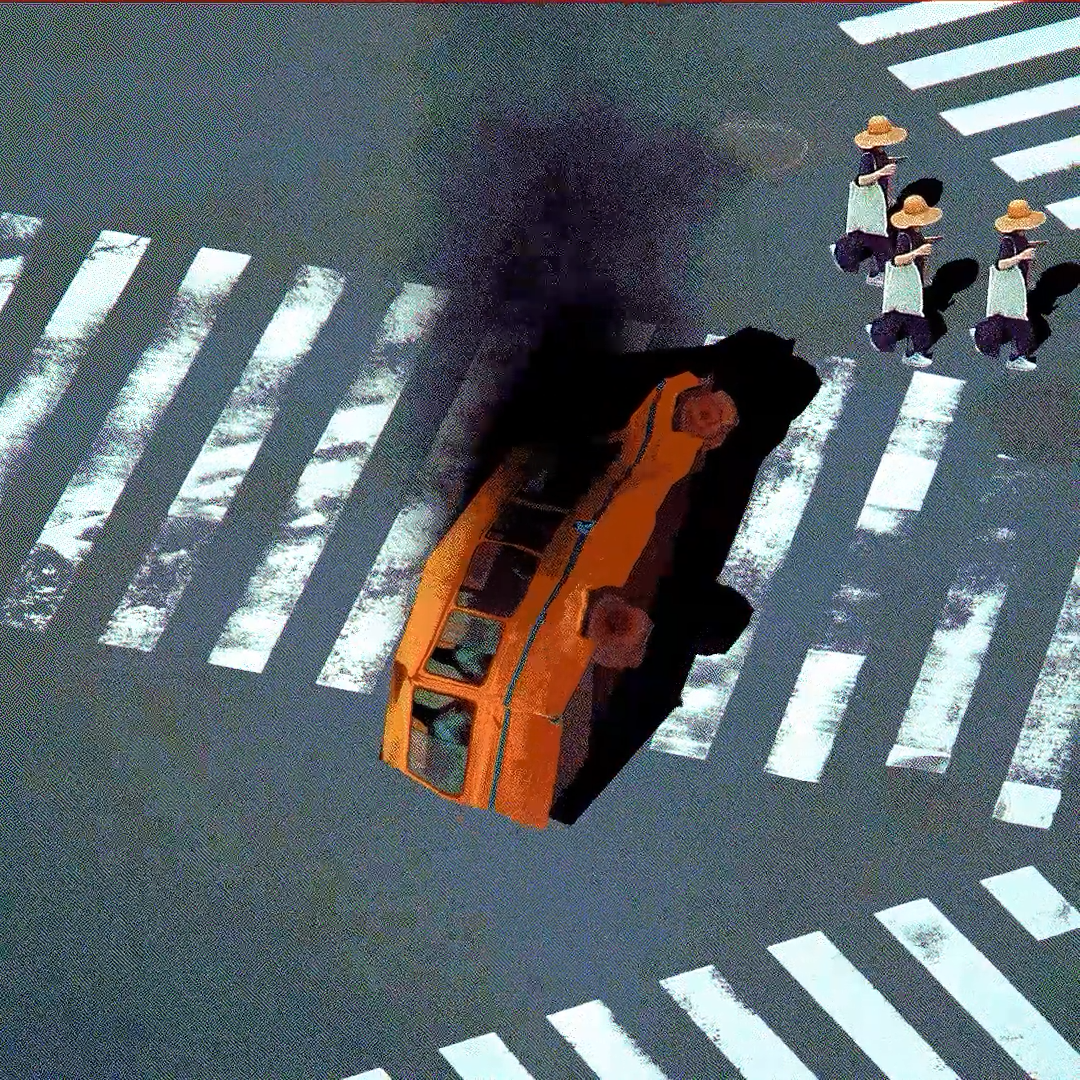10 Questions with CHAMIN
CHAMIN is an artist based in London. She received their MA in Painting from the Royal College of Art in 2022, following a BA in Fine Art from Chelsea College of Arts, University of the Arts London, in 2020.
CHAMIN - Portrait
ARTIST STATEMENT
CHAMIN’s work explores the fact that reality is ultimately beyond our control, a challenge humans have faced for thousands of years. In her art, she looks for comfort in dealing with the unpredictable forces that shape our lives.
At the heart of her practice is what she calls “digital debris.” This is the unfiltered stream of stock video clips and random snapshots she finds online. Stripped of their original context, these bits of media become blank canvases for her imagination.
Using 3D modelling and rendering software, CHAMIN transforms this debris. She might cut out parts of a clip, shuffle its order, insert deliberate glitches, or change a surface’s texture. These small interventions break down the polished look of the source material and uncover surprising connections.
By recombining these impersonal fragments, CHAMIN builds her own set of visual “rules” and patterns, turning chaos into something personally meaningful. Her creative process is both an experiment in form and a way to find reassurance. In a world we can’t control, she shows that we can still create imperfect but comforting frameworks to help us make sense of it.
© CHAMIN
INTERVIEW
First of all, tell us a bit about your journey. What led you from studying painting to working with 3D animation?
I grew up surrounded by PCs, Korea’s early computer boom had me glued to screens long before art school. In my second year of my master’s program, the tutor I admired most began delivering brutally critical feedback that knocked me out of my comfort zone. At the time, it was painful, but it ultimately broke my attachment to traditional painting. When COVID shut our studio, I realised the weight of canvas and paint no longer resonated. After graduating, I spent six months teaching myself Blender, channelling the same curiosity that fueled my childhood, and dove into client work. Two years later, I’ve fully committed to digital video, exploring its unique possibilities for motion, rhythm, and immersive storytelling.
What first drew you to explore the idea of reality as a simulation?
After my uncle died in a hit‑and‑run accident, my grandmother turned to Buddhism to cope. Nearly 90, she still tunes intoBuddhist broadcasts daily, offering water before her TV as an act of devotion. I once asked, “Grandma, do you reallybelieve Buddha exists?” She replied, “Whether he exists or not doesn’t matter. Believing in him strengthens my mind and gives me direction.” That moment revealed faith as a tool for resilience.
I could never fully embrace religion, but I was drawn to science fiction and the rational allure of simulation theory. Believing in a high‑tech “deity” through simulation became my only viable path to faith, it satisfies my spiritual need via science rather than tradition.
© CHAMIN
How do you choose the random online footage you use in your work? Is there something specific you look for?
I used to believe every shot had to come from my own camera, but that mindset limited me. I don’t buy into the idea that you must physically travel or move to find inspiration. The internet, with stock videos, Google Maps flyovers, YouTube clips, and everyday photos, is a vast sea of sources, and even the most commonplace imagery can be infinitely recombined into something new. Now I scroll without an agenda, letting any unexpected image guide me. Whether it’s a cityscape in Street View or a random home video, the vast randomness fuels my creativity and breaks past the constraints of my own reach.
You often mention the tension between destiny and free will. Why are these themes so important to you?
What struck me most was how my grandmother can calmly let go of past events without self‑blame, yet she infuses the future with unwavering optimism, insisting “it’s bound to go well.” That balance, acceptance of fate alongside a seed of hope, felt both paradoxical and profoundly powerful.
Personally, I lean more toward determinism than free will, and I’ve immersed myself in Stoic philosophy. The Stoic teaching, “What’s done is done, focus on what you can do now,” has become a driving force in my work.
Yet every time I recall my grandmother’s example, I strive not to become a pure fatalist. I hold onto the flicker of choice and personal agency even within a predetermined framework. This blend, firm, fate-centred consolation paired with a gentle spark of free will, fuels the emotional tension that gives my art its vitality.
© CHAMIN
© CHAMIN
What role does spontaneity play in your creative process?
I believe artistic creation doesn’t need to be 100% controlled by the artist. Instead, we can collaborate with digital media itself, embracing random glitches, unexpected frame drops, or unplanned transitions. These “mistakes” become new raw material: reused, remixed, and allowed to grow in directions I never scripted.
The most thrilling moments come when an unintended result appears, and I end up loving it. During my tiger piece, a clip I clicked on impulsively led to an unplanned narrative twist that became central to the work. Such serendipitous surprises expand my creativity, sparking ideas I could never have imagined. Few media offer this level of co‑creation with chance: digital tools provide endless opportunities for growth through randomness, where each unforeseen glitch becomes the seed of a fresh concept.
As someone who blends reality and virtual worlds, what do you think digital art can express that traditional painting can’t?
I’ve always hated the weight of the canvas, the heft of cloth and stretcher bars. The larger the painting, the more I found myself stretching my arms and feeling overwhelmed by its physical presence. Working with digital media, however, I feelgod‑like: everything is mine to control. Painting felt entirely opposite; its materiality divides me. That tension made me realise: digital tools let me surpass biases for or against physical weight, offering an intuitive, limitless playground for expression.
What message or feeling do you hope people take away after experiencing your work?
I want to offer a cold yet powerful consolation: acceptance of the unavoidable. Rather than an explosive emotional release, my work invites viewers to let feelings build, then calmly examine and dismantle the seeds of their anxieties, finding real peace in acknowledging what cannot be changed.
© CHAMIN
When you create from a god‑like, omniscient perspective, what kind of questions do you hope viewers ask themselves?
I’d love for viewers to pause not in questioning, but in a brief resignation: “So it was meant to be.” I hope they feel the calm of acceptance rather than anger. That sense of peaceful surrender that “it was destined” is the consolation I find most comforting, and I want them to experience it, even if just for a moment.
How do you see your work evolving in the future? Are there new tools or ideas you’d like to explore?
My grandmother’s faith has deeply inspired me, and I want my work to become more meditative and consoling. I’m exploring how to weave subtle Buddhist influences into my pieces, using rhythm, repetition, and space to evoke calm reflection.
At the same time, I’m fascinated by the idea of expressing consolation not just emotionally but as a refined, analytical obsession. I often imagine diagramming comfort itself, mapping emotional states, tracing the flow of reassurance like a schematic. This dual approach, melding spiritual meditation with a diagrammatic precision, guides my experimental phase, where I test ideas in both immersive simulations and abstract visual systems.
© CHAMIN
And where do you see yourself and your work five years from now?
In five years, I expect to face the inevitable challenges that come simply from living. During those times, I want my work to be more than a creative outlet; I want it to be a structured refuge, like a personal sanctuary I can turn to for immediate comfort. Whenever hardship strikes, I hope to find solace in the very simulations and visual systems I’ve crafted.
To achieve this, I’m developing a living framework: diagrammed consolations, embedded meditative patterns, and interactive simulations that respond to my state of mind. By formalising these elements into a coherent system, almost like a belief practice, I aim to create art that supports me through life’s trials, offering solace exactly when I need it most.
Artist’s Talk
Al-Tiba9 Interviews is a promotional platform for artists to articulate their vision and engage them with our diverse readership through a published art dialogue. The artists are interviewed by Mohamed Benhadj, the founder & curator of Al-Tiba9, to highlight their artistic careers and introduce them to the international contemporary art scene across our vast network of museums, galleries, art professionals, art dealers, collectors, and art lovers across the globe.





















